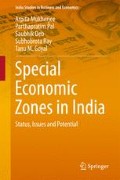Abstract
With its focus on exports, special economic zones are enclaves that receive greater incentives from the government that are often not available to the rest of the country. Many countries over the last century have established such zones with the view to attract investments. There are cases of failure and success, which have key implications and lessons for these zones in India. Within India, special economic zones have not particularly been successful in attracting investments or boosting exports—thereby setting the context for this book to undertake a detailed study of the special economic zones policy in India by suggesting recommendations.
Access this chapter
Tax calculation will be finalised at checkout
Purchases are for personal use only
Notes
- 1.
For details, see http://customs.gov.sd/wp-content/uploads/pdf/KYOTO%20Convention.pdf (last accessed on 3 November 2015).
- 2.
DTA means an area within a country (say, India) that is outside the Special Economic Zones.
- 3.
SEZs: Economic and Technological Development Zones (ETDZs); Free Trade Zones (FTZs); Export Processing Zones (EPZs) and High-tech Industrial Development Zones (HIDZs).
- 4.
The SEZ Act is available at http://sezindia.nic.in/writereaddata/pdf/SEZ%20Act,%202005.pdf and the SEZ Rules are available at http://sezindia.nic.in/goi-policies-sra.asp (accessed on 9 October, 2015).
- 5.
In the recent months, a number of SEZs have been de-notified. The number of approved SEZ has reduced from 564 in September 2014 to 437 on 6 May 2015.
- 6.
IMF’s World Economic Outlook Update, January 2015 (http://www.imf.org/external/pubs/ft/weo/2015/update/01/pdf/0115.pdf), (accessed on 9 October 2015).
- 7.
‘India’s Growth-trends and Imbalances’ by Shankar Acharya in Business Standard, 10 January 2013 available at http://www.business-standard.com/article/opinion/shankar-acharya-india-39s-growth-trends-and-imbalances-113011000137_1.html (accessed on 3 October 2015).
- 8.
‘India’s Growth-trends and Imbalances’ by Shankar Acharya in Business Standard, 10 January 2013 available at http://www.business-standard.com/article/opinion/shankar-acharya-india-39s-growth-trends-and-imbalances-113011000137_1.html (accessed on 3 October 2015).
- 9.
http://www.doingbusiness.org/rankings (accessed on 15 November 2015).
- 10.
http://hdr.undp.org/en/data (accessed on 3 November 2015).
- 11.
Calculated from WTO (2014), Tables I.8 and I.9.
- 12.
Compiled and calculated from United Nations Conference on Trade and Development (UNCTAD) Statistics on International Trade in Services, available at http://unctadstat.unctad.org/ReportFolders/reportFolders.aspx (accessed on 5 September 2013).
- 13.
See also ‘Special Economic Zone—Brain or Drain’ by Kavitha Rao, Business Standard, 8 September 2007.
- 14.
Data provided by the SEZ Division, Department of Commerce.
- 15.
In this book, Andhra Pradesh refers to the erstwhile Andhra Pradesh prior to the bifurcation of the state into Andhra Pradesh and Telangana in 2014.
Author information
Authors and Affiliations
Corresponding author
Rights and permissions
Copyright information
© 2016 Indian Council for Research on International Economic Relations (ICRIER)
About this chapter
Cite this chapter
Mukherjee, A., Pal, P., Deb, S., Ray, S., Goyal, T.M. (2016). Introduction. In: Special Economic Zones in India. India Studies in Business and Economics. Springer, New Delhi. https://doi.org/10.1007/978-81-322-2806-6_1
Download citation
DOI: https://doi.org/10.1007/978-81-322-2806-6_1
Published:
Publisher Name: Springer, New Delhi
Print ISBN: 978-81-322-2804-2
Online ISBN: 978-81-322-2806-6
eBook Packages: Economics and FinanceEconomics and Finance (R0)

